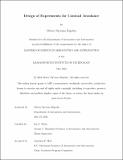Design of Experiments for Contrail Avoidance
Author(s)
Kigotho, Olivier Ng'weno
DownloadThesis PDF (6.153Mb)
Advisor
Waitz, Ian A.
Terms of use
Metadata
Show full item recordAbstract
Condensation trails (contrails) are line-shaped clouds that form behind aircraft and contribute more to climate change each year than any other form of aircraft emissions. While most contrails have little effect on the climate because they dissipate quickly, contrails persist when they form in parts of the atmosphere that are ice-supersaturated (ISS). These ISS regions are often shallow, and can be avoided by small deviations in altitude. However, it is expensive to test whether these deviations are effective, as conducting an experiment requires deviating commercially scheduled flights from their typical cruise altitude. Meanwhile, metrics have not been developed that can compare the costs and benefits of performing contrail avoidance deviations. This thesis shows that measuring the total contrail length avoided relative to the total length of deviations is a way to compare the costs and benefits of contrail avoidance. The results of a Monte Carlo simulation show that a paired difference test will likely reduce the necessary number of samples for statistical significance relative to a randomized control trial. On the other hand, a randomized complete block design with blocking for engine efficiency will not significantly effect the statistical power of the experiment. However, the instrument used to measure contrails will have the greatest effect on the number of samples needed because the number of samples necessary for statistical significance scales inversely proportionally to the probability that an instrument will observe a contrail. Finally, these simulations suggest that the benefit of contrail avoidance is sensitive to costs of performing deviations besides fuel burn. Therefore, a contrail avoidance policy should prioritize avoiding longer contrails over shorter ones to reduce the number of deviations necessary for a given benefit. It is expected that contrail avoidance experiments will be necessary at multiple stages of scaling up the contrail avoidance system. As a result, using these experiment designs will be useful to compare different strategies of contrail avoidance and different prediction systems. Knowing how to measuring the effect of contrail avoidance will take us one step closer to mitigating the climate impacts of the aviation industry.
Date issued
2024-05Department
Massachusetts Institute of Technology. Department of Aeronautics and AstronauticsPublisher
Massachusetts Institute of Technology